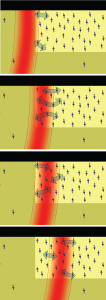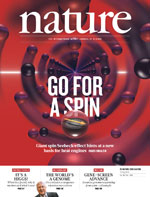Recent CEM results published in Nature Nanotechnology
Could diamonds be a computer’s best friend?
March 24, 2014
 For the first time, CEM researchers have demonstrated that information can flow through a diamond wire. In the experiment, electrons did not flow through diamond as they do in traditional electronics; rather, they stayed in place and passed along a magnetic effect called “spin” to each other down the wire—like a row of sports spectators doing “the wave.
For the first time, CEM researchers have demonstrated that information can flow through a diamond wire. In the experiment, electrons did not flow through diamond as they do in traditional electronics; rather, they stayed in place and passed along a magnetic effect called “spin” to each other down the wire—like a row of sports spectators doing “the wave.
Spin could one day be used to transmit data in computer circuits—and this new experiment, done at The Ohio State University, revealed that diamond transmits spin better than most metals in which researchers have previously observed the effect.
Further information on this research can be found in this article and in the publication.


 Exciting results which report an amplified “spin-Seebeck effect”, conducted by Christopher Jaworski, Roberto Myers, Zeke Johnston-Halperin and Jos Heremans, were published in the July 12th issue of Nature. The researchers are studying a magnetic effect which converts heat to electricity, called the “spin-Seebeck effect”, in which a flow of heat creates a current of electron spins in a magnetic material.
Exciting results which report an amplified “spin-Seebeck effect”, conducted by Christopher Jaworski, Roberto Myers, Zeke Johnston-Halperin and Jos Heremans, were published in the July 12th issue of Nature. The researchers are studying a magnetic effect which converts heat to electricity, called the “spin-Seebeck effect”, in which a flow of heat creates a current of electron spins in a magnetic material.